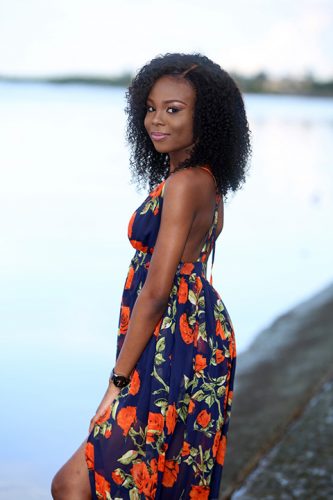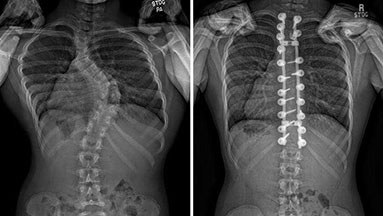For most of her life, Shemaiah Enoe’s family did not know that there was anything wrong with her.
Her mother, Shonell Enoe, said it was not until the girl was around 13-years-old that a friend pointed out that something about the alignment of her shoulders and back looked a bit off. The friend suggested that it might be scoliosis, a condition where there is a sideways curvature of the spine.
The Enoe family were advised to take the young girl to a hospital for an examination and it was there that she was diagnosed by Dr Fawcett Jeffrey.
 With little to no knowledge of the condition, Shonell took to Google to educate herself after Dr. Jeffrey had insisted that they do an x-ray of Shemaiah’s spine. Shonell noted that this proved to be the turning point in understanding the severity of her daughter’s condition. The teenager’s x-ray showed that her spine was beyond the 45 degree curve that is treatable with the use of back braces or physiotherapy.
With little to no knowledge of the condition, Shonell took to Google to educate herself after Dr. Jeffrey had insisted that they do an x-ray of Shemaiah’s spine. Shonell noted that this proved to be the turning point in understanding the severity of her daughter’s condition. The teenager’s x-ray showed that her spine was beyond the 45 degree curve that is treatable with the use of back braces or physiotherapy.
Now 16-years-old, Shemaiah will be undergoing surgery later this month in the United States.
The possibility for her to be able to live a normal life with a normal spine was granted to her after her doctor, Hyder Khan, who after meeting her when she was first diagnosed with scoliosis made her a priority and got her onto a waiting list so she could undergo the surgery through SpineHope, a US non-profit organisation that is dedicated to providing advanced treatment to children around the world suffering from severe spinal deformities.
Shonell shared that she had become a bit scared and has always been nervous after seeing the doctors’ reactions to Shemaiah’s x-rays “Because you could not visibly see any issues with Shemaiah’s spine. When the doctors did the x-rays they would be very surprised. I was a bit scared because even trainees were wowed by it… and they knew it was severe,” she explained. From the experience she had, she strongly advises that parents take their children to get checked out. “Even the smallest of things needs to be checked,” she said.
This is also the view of Dr Keith Cummings, who specialises in chronic diseases. In an interview, he said scoliosis “is a very common disorder among Guyanese” and is merely one of the many health issues many Guyanese have but don’t know they have.
“This is because as parents, we commonly overlook things with our children by saying ‘Oh, he/she will grow out of it,’” he noted.
Dr Cummings said parents need to move away from the social norm in Guyana where they see their children with noticeable defects but overlook them, as it is the reason many persons have illnesses but don’t get treatment until it is too late.
He added that the idea time for the condition to be treated is while the affected person is young so that as they grow, the curvature of the spine can be corrected.
According to the Mayo Clinic website, scoliosis is a sideways curvature of the spine that occurs most often during the growth spurt just before puberty. “While scoliosis can be caused by conditions such as cerebral palsy and muscular dystrophy, the cause of most scoliosis is unknown,” it explains, while noting that about 3% of adolescents have the condition.
Most cases are “mild” and no treatment is necessary but it is noted that some spine deformities continue to get more severe as children grow and could require to either wear a back brace or even undergo surgery. “Severe scoliosis can be disabling. An especially severe spinal curve can reduce the amount of space within the chest, making it difficult for the lungs to function properly,” the site adds.
The common symptoms of the condition include uneven shoulders, waist or hips.
No limitations
Like in Shemaiah’s case, Imani McKenzie’s family noticed that her shoulders were not leveled and her spinal cord was a bit curved when she was between the ages of 13 and 14. However, it was not a surprise as she comes from a family of persons with the condition. “I was never diagnosed with scoliosis; it was something hereditary for me,” the young woman, now a 20-year-old optometry student at the University of Guyana, said. “My mom and my sister have scoliosis, and my mom… her sisters have scoliosis too.”
Since her condition was not as severe as Shemaiah’s, it has not been particularly rough on McKenzie’s day to day life. She did, however, say that she tries to ensure she has good posture but she added that when she stands for too long her back hurts. She also said that fetching heavy loads can also put a strain on her back.
She noted that her mother and sister constantly tell her to do simple exercises, which may prevent the curvature from progressing. She was advised to undergo physiotherapy and to wear a back brace. Swimming has also been recommended but she noted that she has not been disciplined with the activity.
When asked about her self-confidence as a person living with scoliosis, McKenzie spoke about how she was troubled by a boy in her class during her high school days. She said he would tease her about the way she walked. “I was mostly mad at him and saddened by the fact that he was laughing about something that he didn’t understand. I am strong about it but I think about…what if some other girl or child who was affected (couldn’t handle the constant teasing). So I was really mad at him for trying to imitate the way I would walk,” she noted.
McKenzie went on to say that her confidence is in no way lowered by having the condition and that she actually uses people’s curiosity about how her back looks and the way she walks as a platform to raiser bringing awareness about scoliosis. “I was never shy about it when people would ask, I would tell them about it,” she said.
For further support, McKenzie is a part of ‘Curvy Girls Guyana,’ which is a support group for girls living with scoliosis in Guyana. In the group, girls from ages 12 to 22 come together and discuss their experiences of living with scoliosis. She explained that the understanding of what she is going through can be found in the group.
McKenzie also advises that persons with scoliosis look at themselves as normal. “It’s just a curve in your back, it’s nothing to be ashamed of,” she said. “There are no limitations to what I could do living with scoliosis.”
Did not stop
However, the experiences of those with scoliosis vary according to the severity of their condition. A medical student at the University of Guyana, who is living with the condition, noted that she was an athlete when she was diagnosed. “Usain Bolt has it too, you know?” said the young woman, who did not want to be named.
She had been around the same age as both Enoe and McKenzie when she was diagnosed. She had been training to go to Barbados when her aunt noticed that one side of her shoulder looked a bit higher than the other side. After being taken to the Woodlands Hospital, where she was treated by an orthopaedist, she tried physiotherapy, which was recommended and it helped a bit. She also said that she later enrolled at the National School of Dance, where there was a class for persons with scoliosis. She also took up swimming. She added that she did not stop running nor exercising after her diagnosis but that due to pain she had to reduce strenuous activities but not completely cut them out of her life.
That being said, the young woman noted that at the time of her diagnosis her scoliosis was not yet severe but it caused a lot of straining for her when it came to breathing. “I would experience a lot of pain,” she said, “depending on the different positions I would be in, that’s how it would hurt.”
Like Enoe, whose spinal curvature is beyond 45 degrees, the young woman explained that her condition is slightly-severe and so she experienced pain frequently. She added that even though she did not like taking painkillers, sometimes the pain would be so unbearable that she would have to.
When she was asked how being diagnosed affected her life given that she was also a teen at the time, she said that most people did not know she was diagnosed and that she would wear loose clothing so people couldn’t notice the misalignment of her shoulder. “My nieces and nephews would jump on my back” she said gleefully as she reminisced the times she was heavily supported by her family.
She noted that Dr Victor Allen, an orthopaedist at the Georgetown Public Hospital, was one of the most supportive doctors as he was the one who recommended that she get a back brace. The use of back braces are usually treatments that help to stop the curvature of the spine from getting worse, Enoe noted that had they known the severity of Shemaiah’s spinal curvature earlier, the back brace might have been recommended instead of surgery.
Just like Enoe and McKenzie, she pointed out the need for early diagnosis because of how expensive the treatment can be once the curvature progresses to a severe stage.





